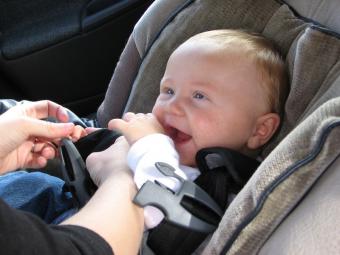
With the many options on the market, buying an infant car seat can seem overwhelming for parents. Knowing which features are important and how to choose the best seat for your new baby can help make the process easier.
Buyer's Guide to Infant Car Seats
In most cases, your baby will use his rear-facing infant seat for up to one year. Most infant seats are designed to snap into a base that stays installed in your vehicle. You can snap the seat out, and carry the sleeping baby into the house without enduring the hassle of unfastening the straps and waking up your little one. Infant car seats typically retail between $60 and $400, and there are a lot of factors to take into consideration when making this investment.
Installation Methods
One of the first things to think about when buying a car seat is how you plan to install it in your vehicle. According to Carseat.org, cars have been required to have lower anchors and tethers (LATCH), or bars specially-designed for car seat installation, since 2002. Many cars made prior to that time also have LATCH, but not all of them do. If your vehicle has LATCH, you'll be able to use these bars to securely install the car seat or its base. If not, you'll need to be sure the car seat is compatible with a standard seatbelt.
The vast majority of infant seats come with the base. Many companies also sell bases separately, and you can purchase a second base to go in another car. Alternatively, some car seats work both with and without the base. As you shop, you'll want to consider whether you'll need to use the seat in more than one vehicle and if you want to invest in a second base for it.
Safety Features and Ease of Use
In order to be sold to US consumers, infant seats must meet federal safety standards. Beyond that, there are optional safety features that may make specific seats more attractive to parents. These include additional points where the seat is secured to the vehicle, integrated side impact and head protection for your baby, an integrated level in the base to ensure proper installation, and more.
There are no publicly available crash test ratings for car seats, but the National Highway Traffic Safety Administration (NHTSA) does test car seats for ease of use. This is important because proper installation of your seat is essential for it to do its job in protecting your baby.
Size
Most cars can comfortably accommodate any infant car seat, but all seats are designed slightly differently. Before purchasing a seat, it's a good idea to measure the available space where you plan to install it. Then you can compare the dimensions of the seat, which will vary for each model, with the space in your vehicle.
Cost
There's a great deal of variability in the pricing of infant car seats. Although a $60 seat meets all safety standards, it may not have the additional safety features and convenience amenities that you need. At the same time, more expensive seats are not necessarily better. Take your time evaluating the features of an infant seat and your budget before deciding on the right model for you.
Convenience Features
Convenience features are often what set a budget seat apart from more expensive models. These can include the following:
- Easy, one-hand adjustment of straps
- Multiple harness heights to extend the use of the seat as your child grows
- Compatibility with strollers and travel systems
- Lightweight for carrying when not in the car
- Well-designed carrying handle that is comfortable for parents
- Ability to use for travel on an airplane
Buying a Used Seat
It is never a good idea to purchase a used infant car seat. Car seats come with expiration dates, usually around six years. Seats are also recalled from time to time, and a used seat may be affected by one of these events. In addition, if the seat has been in a crash, it may not be able to adequately protect your baby.
An Important Decision
Choosing a car seat for your infant is an important decision, but keep in mind that every new car seat on the market meets or exceeds the government safety standards. Ultimately, as long as your baby is in a properly-installed infant car seat and meets the height and weight requirements for that seat, he is very well protected in the event of an accident.







